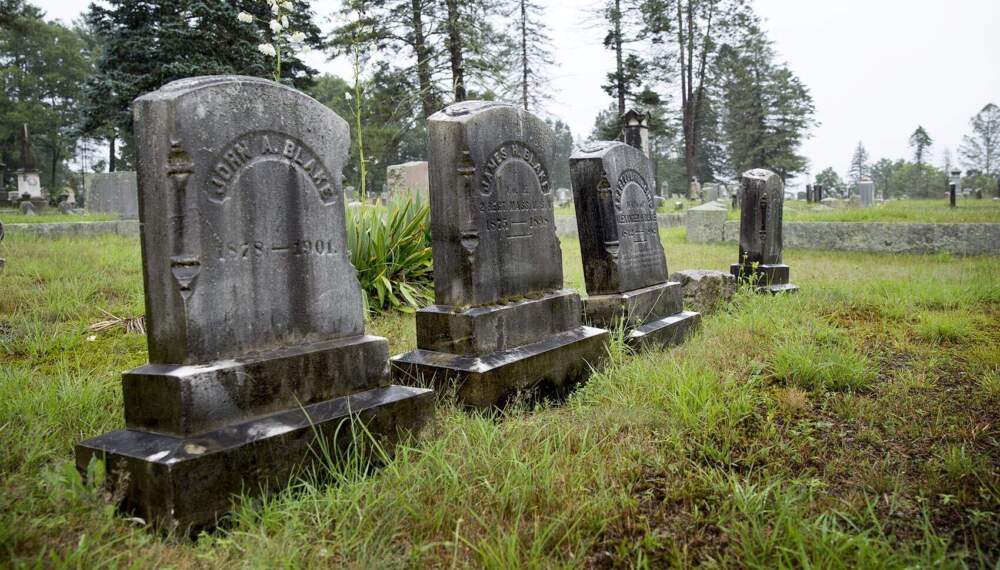Advertisement
The Weekender: Boston's Saturday Morning Newsletter
How history made New England a prime setting for horror stories

Editor's Note: This is an excerpt from WBUR's Saturday morning newsletter, The Weekender. If you like what you read and want it in your inbox, sign up here.
Tim Burton’s films make up the majority of my “required viewing” list around Halloween (mostly because I love the dramatic scores and spooky plots, partly because I can’t handle anything scarier). While “Beetlejuice” may be the director’s most notable film set in New England, Burton’s 2012 comedy “Dark Shadows” pulls from the region’s literary history to craft a uniquely American fantasy tale.
Set in Maine in 1790, the film’s protagonist (played, of course, by Johnny Depp) is a philandering English settler who becomes a vampire after being cursed by a jealous witch. Centuries after being buried alive by an angry mob, the vampire awakens in the 1970s and has to adjust to 20th century life — and, wouldn’t you know it, comedic chaos ensues.
It’s not Burton’s best. But it did get me thinking about how New England exists as a setting for horror stories. In fact, there’s an entire genre named for these types of books and movies: New England Gothic.
“There’s a tendency to set horror films in New England particularly because of the connection with Gothic literature,” said Ned Hinkle, creative director at the Brattle Theatre. But not every scary story or movie set in New England falls into the Gothic genre.
According to Bridget Marshall, a professor of English at UMass Lowell and expert in Gothic literature, Gothic tales are always centered around a secret. “Sometimes that secret is something from the past, like a buried body or a hidden family relationship, but it could also be a new horror that’s emerging … some kind of monster, like a vampire, for instance,” said Marshall.
Gothic stories also always borrow from the region’s history and landscape to create a sense of isolation, uneasiness and fear. And in New England — the oldest settled part of the United States — there are plenty of real life horrors writers and directors can pull from, including our ever-changing seasons.
In the era of writers Nathaniel Hawthorne and Edgar Allan Poe, “people were terrified of the winter because they didn’t know if they would survive,” said Regina Hansen, a lecturer at Boston University. “The fear of isolation and freezing to death … there’s good reason for that.”
Hinkle agrees, noting “The Witch” by Robert Eggers is great example of this on screen. “[It’s] a fantastic film set in the winter woods of New England,” said Hinkle. “There’s something about those winter woods that lend themselves to a haunting atmosphere.”
Apart from the cold, dark winter nights that make New England especially spooky, there are centuries of untold stories about the brutal violence that occurred here.
“We know what a ghost is. It’s something that’s there and not there,” says Hansen. “History is a ghost, too. The Gothic is a lot of things, but it’s mainly about suppressed and hidden histories — especially like the ones we have here. The witch trials. The destruction of the Native peoples. Slavery. Those historical elements continue to haunt us.”
And haunt they do. People come from far and wide to visit Salem to see where women were executed for “being witches” or take a trip to Boston to walk through the crypt of Boston’s Old North Church.
“The Gothic is always interested in history, and New England has a deep and layered one,” said Marshall. “These historical events have captured imaginations and taken on lives of their own. And we keep re-telling the stories, so they stay alive.”
Authors most notably inspired by the haunted history of New England include Shirley Jackson, Hawthorne, H.P. Lovecraft, Poe and Stephen King; as well as a number of filmmakers, including Nicholas Hynter and John Madden, who recreated mainstay New England Gothic novels “The Crucible” and “Ethan Frome” for the big screen.
This Halloweekend, why not indulge in some close-to-home fright? Here are a few New England Gothic books, short stories and films that Hansen, Hinkle and Marshall recommend:
- “The Reach” and “Salem’s Lot,” Stephen King
- “The Lottery” and “The Haunting of the Hill House,” Shirley Jackson
- “The Giant Wistaria,” Charlotte Perkins Gilman
- “The Asylum: Or, Alonso and Melissa. An American Tale, Founded on Fact,” Daniel Jackson
- “Session 9” (2001), directed by Brad Anderson and filmed in Danvers
- “Pet Sematary” (1989) directed by Mary Lambert
P.S. — If you’d rather watch a horror movie and scream along with a crowd, WBUR resident film critic Sean Burns has compiled a list of six especially scary films showing at theaters around Boston this week. Happy Halloween!
